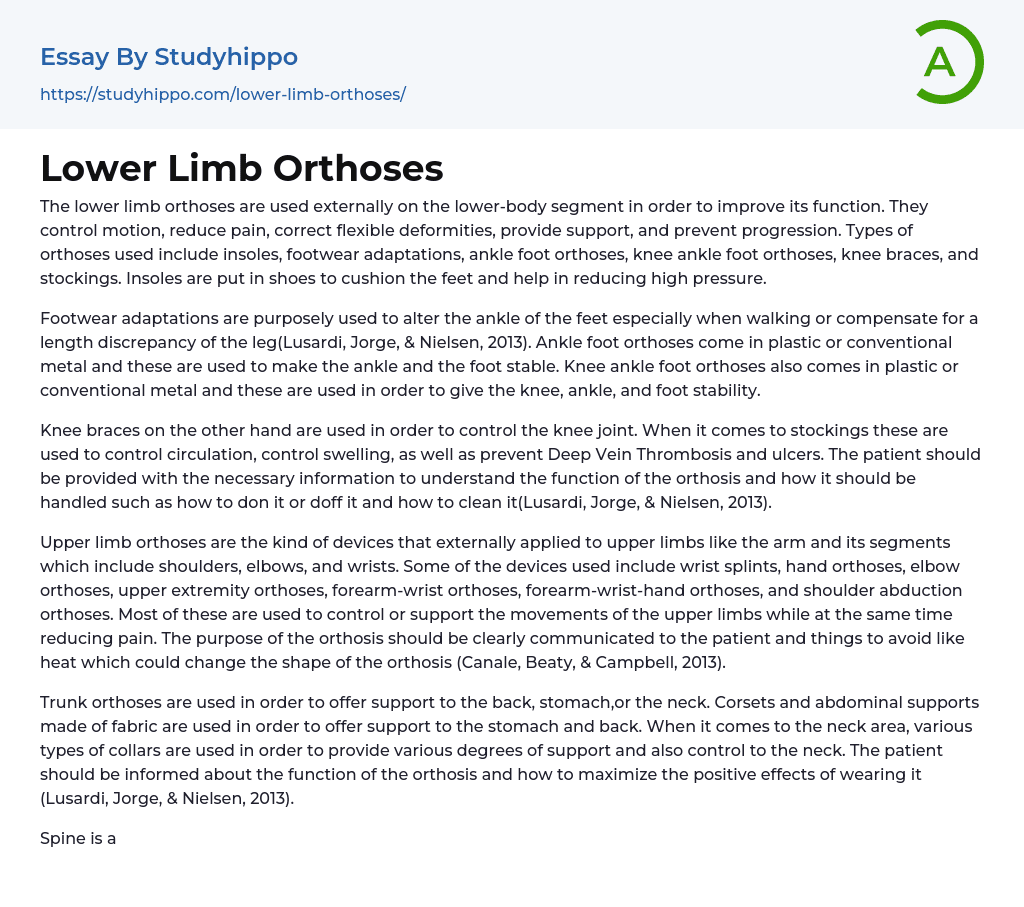The use of lower limb orthoses is aimed at improving the function of the lower-body segment. These external devices control motion, alleviate pain, correct flexible deformities, offer support, and prevent further problems. They come in various forms such as insoles, footwear adaptations, ankle foot orthoses, knee ankle foot orthoses, knee braces, and stockings. Insoles are specifically inserted into shoes to provide cushioning for the feet and help alleviate high pressure.
Footwear adaptations are intentionally employed to modify the ankle of the feet during walking or to compensate for leg length discrepancies (Lusardi, Jorge, & Nielsen, 2013). Ankle foot orthoses, made of plastic or conventional metal, are utilized to provide stability to the ankle and foot. Similarly, knee ankle foot orthoses, available in plastic or conventional metal, aim to stabilize the knee, ankle, and foot. Conve
...rsely, knee braces are utilized for knee joint control. Lastly, stockings are employed to manage circulation, swelling, as well as prevent Deep Vein Thrombosis and ulcers.
It is important to provide the patient with information on the function and handling of the orthosis, including how to put it on, take it off, and clean it (Lusardi, Jorge, & Nielsen, 2013). Upper limb orthoses are external devices that are applied to the arm and its segments, such as shoulders, elbows, and wrists. Examples of these devices include wrist splints, hand orthoses, elbow orthoses, upper extremity orthoses, forearm-wrist orthoses, forearm-wrist-hand orthoses, and shoulder abduction orthoses. These devices are used to control or support upper limb movements and reduce pain. It is important to clearly communicate the purpose of the orthosis to the patient and inform them about things to avoid, such as heat that could
alter its shape (Canale, Beaty, & Campbell, 2013). Trunk orthoses are used to provide support for the back, stomach, or neck.
Fabric corsets and abdominal supports are utilized to provide support for the stomach and back. Different types of collars are utilized for the neck area to offer varying levels of support and control. It is important to educate the patient on the purpose of the orthosis and how to optimize its benefits (Lusardi, Jorge, & Nielsen, 2013). The spine is a complex component of the body, consisting of four main segments: the cervical spine, thoracic spine, lumbar spine, and sacral portion.
All parts of the spine are distinct and respond differently to orthotic stabilization. Each part requires a specific type of orthosis depending on the injury or condition. However, only a few pathologies necessitate orthoses that span from the cervical spine to the sacrum. Plastic spinal supports, which are tighter than corsets, are used to control movement and provide support to the body. These supports may be used to avoid surgery or after surgery has been performed (Hsu, Michael, Fisk, & American Academy of Orthopaedic Surgeons, 2008). Post-orthosis precautions include referencing diagrams or videos that demonstrate how to wear the orthosis and how to limit or minimize movement.
The patient also has the right to be informed about potential issues that may arise from wearing the orthosis (Canale, Beaty, & Campbell, 2013). Considering the spine's sensitivity, it is important for a specialist to apply the orthosis in order to achieve the desired function or outcome.
- alternative medicine essays
- Aspirin essays
- Cannabis essays
- Cardiology essays
- Cloning essays
- Dentist essays
- drugs essays
- Hemoglobin essays
- Medical essays
- Medical Ethics essays
- Organ Donation essays
- Patient essays
- Pharmacology essays
- Plastic Surgery essays
- Surgery essays
- Therapy essays
- Vaccines essays




